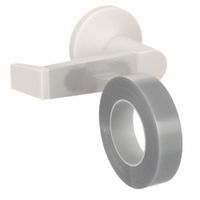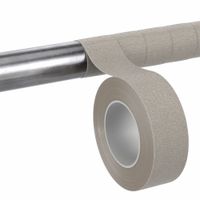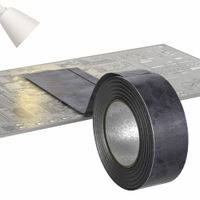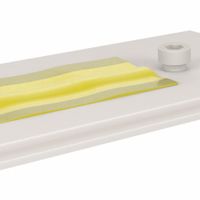Call +(254) 703 030 000 / 751 483 999 / 721 704 777
- Home
- Adhesives Sealants And Tape
- Tape
- Specialty Application Tape
.....Read More
Frequently Asked Questions
What is specialty application tape used for?
Specialty application tape is used primarily in the sign-making and graphics industries to transfer cut vinyl graphics and decals from their backing paper to the desired surface. This tape is essential for ensuring that the design maintains its integrity and alignment during the transfer process. It comes in various tack levels, which refer to the adhesive strength, allowing users to choose the appropriate tape based on the type of vinyl and the surface to which it will be applied.
The tape is typically made from paper or plastic film and is transparent or semi-transparent, enabling precise positioning of the graphics. It is particularly useful for multi-layered designs, as it allows for accurate placement of each layer. Specialty application tape can also be used for screen printing, where it helps in the alignment and registration of multiple colors.
In addition to its primary use in vinyl graphics, specialty application tape is employed in other industries for tasks that require temporary adhesion. For example, it can be used in crafting, automotive detailing, and even in the installation of wall decals and murals. The tape's ability to hold components in place without leaving residue makes it versatile for various applications.
Overall, specialty application tape is a crucial tool for professionals and hobbyists alike, facilitating the precise and clean transfer of intricate designs and ensuring high-quality results in decorative and functional applications.
How do you choose the right specialty application tape for a specific task?
To choose the right specialty application tape for a specific task, consider the following factors:
1. **Surface Type**: Identify the surface material (e.g., glass, metal, plastic, wood) to ensure compatibility. Some tapes are designed for smooth surfaces, while others work better on textured or rough surfaces.
2. **Adhesive Strength**: Determine the level of adhesion required. For temporary applications, a low-tack tape is suitable, whereas permanent applications may require high-tack or extra-strong adhesive.
3. **Temperature Resistance**: Consider the environmental conditions. If the application involves exposure to high temperatures or extreme weather, select a tape with appropriate thermal resistance.
4. **Moisture and Chemical Resistance**: For applications in humid or chemically exposed environments, choose a tape with moisture and chemical resistance to ensure durability.
5. **Flexibility and Conformability**: For irregular or curved surfaces, opt for a tape that offers flexibility and conformability to ensure a smooth application without wrinkles or bubbles.
6. **Transparency and Color**: Depending on the aesthetic requirements, select a tape that is either transparent or matches the color of the surface for a seamless appearance.
7. **Thickness and Durability**: Evaluate the thickness needed for the task. Thicker tapes may provide more durability and cushioning, while thinner tapes are less obtrusive.
8. **Application Method**: Consider the ease of application. Some tapes come with easy-release liners or are designed for specific application tools.
9. **Removal and Residue**: If the tape needs to be removed later, ensure it can be taken off cleanly without leaving residue or damaging the surface.
10. **Cost and Availability**: Finally, balance the cost with the quality and availability of the tape to ensure it meets budgetary constraints without compromising on performance.
What are the benefits of using specialty application tape?
Specialty application tape offers several benefits, particularly in industries where precision and quality are paramount. Here are the key advantages:
1. **Enhanced Precision**: Specialty application tapes are designed to provide precise alignment and placement of graphics, decals, or lettering. This ensures that the final application is accurate and professional-looking.
2. **Versatility**: These tapes are available in various adhesive strengths and materials, making them suitable for a wide range of surfaces and applications, from delicate substrates to more robust materials.
3. **Ease of Use**: Specialty tapes often come with features like easy-release liners and clear or translucent backings, which help in positioning and transferring designs without hassle.
4. **Time Efficiency**: By facilitating quick and accurate application, these tapes reduce the time spent on manual adjustments and corrections, thereby increasing productivity.
5. **Protection**: They protect the graphics or decals during the application process, preventing damage such as stretching, tearing, or wrinkling.
6. **Reduced Waste**: The precision and ease of use minimize errors, leading to less material waste and cost savings.
7. **Consistency**: Specialty tapes ensure consistent application results, which is crucial for maintaining brand standards and quality control.
8. **Temperature and Weather Resistance**: Many specialty tapes are designed to withstand various environmental conditions, ensuring durability and longevity of the applied graphics.
9. **Customizability**: They can be tailored to specific project needs, including custom widths, lengths, and adhesive properties, providing flexibility for different applications.
10. **Improved Aesthetics**: By ensuring clean and precise application, specialty tapes enhance the overall appearance of the finished product, which is vital for customer satisfaction and brand image.
Can specialty application tape withstand high temperatures?
Specialty application tapes are designed for specific purposes and can vary significantly in their ability to withstand high temperatures. Some specialty tapes are engineered to endure extreme conditions, including high temperatures, while others are not. The ability of a specialty application tape to withstand high temperatures depends on its material composition and intended use.
High-temperature specialty tapes are typically made from materials such as polyimide, polyester, or glass cloth, which are known for their thermal resistance. These tapes often have silicone or acrylic adhesives that can maintain their bond at elevated temperatures. For instance, polyimide tapes, commonly known as Kapton tapes, can withstand temperatures up to 500°F (260°C) or higher, making them suitable for applications like electrical insulation, wave soldering, and powder coating.
On the other hand, tapes not specifically designed for high-temperature applications may fail when exposed to heat. The adhesive may soften, lose its tack, or degrade, and the backing material may shrink, melt, or become brittle. Therefore, it is crucial to select a tape that matches the temperature requirements of the application.
When choosing a specialty application tape for high-temperature environments, consider the maximum temperature the tape will encounter, the duration of exposure, and the specific application requirements. Always refer to the manufacturer's specifications to ensure the tape's suitability for the intended use.
Is specialty application tape suitable for electrical insulation?
Specialty application tape is generally not suitable for electrical insulation. Electrical insulation requires materials that can effectively prevent the flow of electric current, withstand high temperatures, and resist environmental factors such as moisture and chemicals. Specialty application tapes are designed for specific purposes, which may not include electrical insulation.
Electrical insulation tapes, such as PVC electrical tape, are specifically engineered to provide the necessary dielectric strength, thermal resistance, and durability required for insulating electrical wires and components. These tapes are made from materials that can handle the electrical load and environmental conditions typically encountered in electrical applications.
In contrast, specialty application tapes may be designed for purposes such as surface protection, bonding, masking, or sealing, and may not possess the necessary properties for electrical insulation. Using a tape not intended for electrical insulation can lead to safety hazards, including electrical shorts, fires, or equipment failure.
Therefore, it is crucial to use the appropriate type of tape specifically designed for electrical insulation to ensure safety and functionality in electrical applications.
How do you apply specialty application tape correctly?
To apply specialty application tape correctly, follow these steps:
1. **Prepare the Surface**: Ensure the surface where the vinyl will be applied is clean and dry. Use a lint-free cloth and a suitable cleaner to remove dust, grease, or any contaminants.
2. **Cut the Tape**: Measure and cut the application tape to the size of the vinyl graphic, leaving a little extra on each side for easier handling.
3. **Position the Tape**: Lay the application tape sticky side up on a flat surface. Carefully place the vinyl graphic face down onto the tape, ensuring it is centered and aligned properly.
4. **Adhere the Tape**: Use a squeegee or a similar tool to press the vinyl onto the application tape. Start from the center and work your way outwards to eliminate air bubbles and ensure full adhesion.
5. **Trim Excess Tape**: If necessary, trim any excess application tape around the edges of the vinyl graphic for easier handling and positioning.
6. **Position the Graphic**: Carefully lift the application tape with the vinyl attached and position it on the target surface. Use alignment marks or guides if needed to ensure correct placement.
7. **Apply the Graphic**: Once positioned, use a squeegee to firmly press the vinyl onto the surface. Start from the center and work outwards to remove air bubbles and ensure strong adhesion.
8. **Remove the Tape**: Slowly peel back the application tape at a sharp angle, ensuring the vinyl remains adhered to the surface. If any part of the vinyl lifts with the tape, press it back down and squeegee again.
9. **Final Inspection**: Check for any air bubbles or misalignments. Use a pin to gently pop any bubbles and smooth them out with a squeegee.
10. **Cure Time**: Allow the vinyl to set and cure as per the manufacturer's instructions before exposing it to stress or environmental factors.
Where can I buy specialty application tape?
You can buy specialty application tape from a variety of sources, including:
1. **Online Retailers**: Websites like Amazon, eBay, and specialty craft sites such as Etsy often have a wide selection of application tapes. These platforms offer customer reviews and ratings, which can help in making an informed decision.
2. **Specialty Craft Stores**: Stores like Michaels, Hobby Lobby, and Joann Fabrics often carry application tapes, especially those used for crafting and DIY projects. They may also offer in-store pickup or delivery options.
3. **Sign Supply Companies**: Companies that specialize in sign-making supplies, such as Grimco, Fellers, or SignWarehouse, offer a range of application tapes designed for professional use. These tapes are often used for vinyl graphics and sign applications.
4. **Industrial Suppliers**: Companies like Uline or Grainger provide specialty tapes for industrial applications. These suppliers often have a broader range of tapes for specific industrial needs.
5. **Manufacturer Websites**: Brands that produce application tapes, such as 3M or Oracal, often sell directly through their websites or provide a list of authorized distributors.
6. **Local Hardware Stores**: Stores like Home Depot or Lowe’s may carry a selection of application tapes, particularly those used for home improvement or repair projects.
7. **Wholesale Distributors**: For bulk purchases, consider contacting wholesale distributors who specialize in tapes and adhesives. They often offer competitive pricing for large orders.
8. **Custom Printing Shops**: Some local print shops that offer custom printing services may also sell application tapes, especially if they provide vinyl cutting services.
When purchasing, consider the specific requirements of your project, such as the type of surface, the size of the tape needed, and any specific adhesive properties required.




